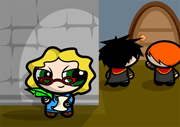Articles
Witch-Burning in the Fourteenth Century
Ronja Liek (Gryffindor)
In A History of Magic, Adalbert Waffling mentions medieval muggles briefly. "Non-magic people," he writes, "were particularly afraid of magic in medieval times, but not very good at recognizing it. On the rare occasion that they did catch a real witch or wizard, the burning had no effect whatsoever."
The rare occasion? Some might have frowned upon those three words put together. Rare occasion? Weren’t there hundreds, thousands of victims? Was that "rare"? Or were they muggles? If they were, why didn’t the magical community help them?
The truth is, Adalbert was right, indeed. There were only very, very few witch burnings in medieval times, for witch burning was more of a Renaissance practice.
In medieval times, the average muggle did believe in witchcraft and wizardry, but the church leaders considered witchcraft to be nothing more than chasing after dreams or illusions, or at the very most (in case someone used witchcraft to get a husband or wife), as a sin against marriage.
That is why, in most cases, witchcraft was mostly punished with churchly punishment, such as a forced pilgrimage or 2 to 7 years living without "bodily pleasures."
Canon law followed the views of the church father Augustine of Hippo (AD 400), saying that belief in the existence of witchcraft was heresy. According to Augustine, “a heretic is one who either devises or follows false and new opinions, for the sake of some temporal profit.” Since it was a crime to believe someone was a witch, it was hard to convict someone as a witch.
It was not until the year 1484 (the 15th century and at the very end of medieval times) that Pope Innocentius VIII wrote a paper in which he suggested putting a stop to witchcraft. It took two more years for Heinrich Kramer and Jacob Sprenger, two monks, to write Malleus Maleficarum, a book that was supposed to be a manual to judges when they had to face a witch in court, but mostly the book was just anti-female.
Even after that, in the Dutch medieval play “Mariken van Nieumeghen” (ca 1500), where the main character confesses to have been the Devil’s companion for a period of seven years, the priests, bishops and even the pope forgive her and leave her punishment to God.
The real prosecution of witches began somewhere around the year 1450, but the real peak of it was not until the 17th century. In the year 1782, when the whole craze ended, a few hundred thousands of women (and some men) had been burned as witches. Whether the magical community did anything to help them is unknown.
